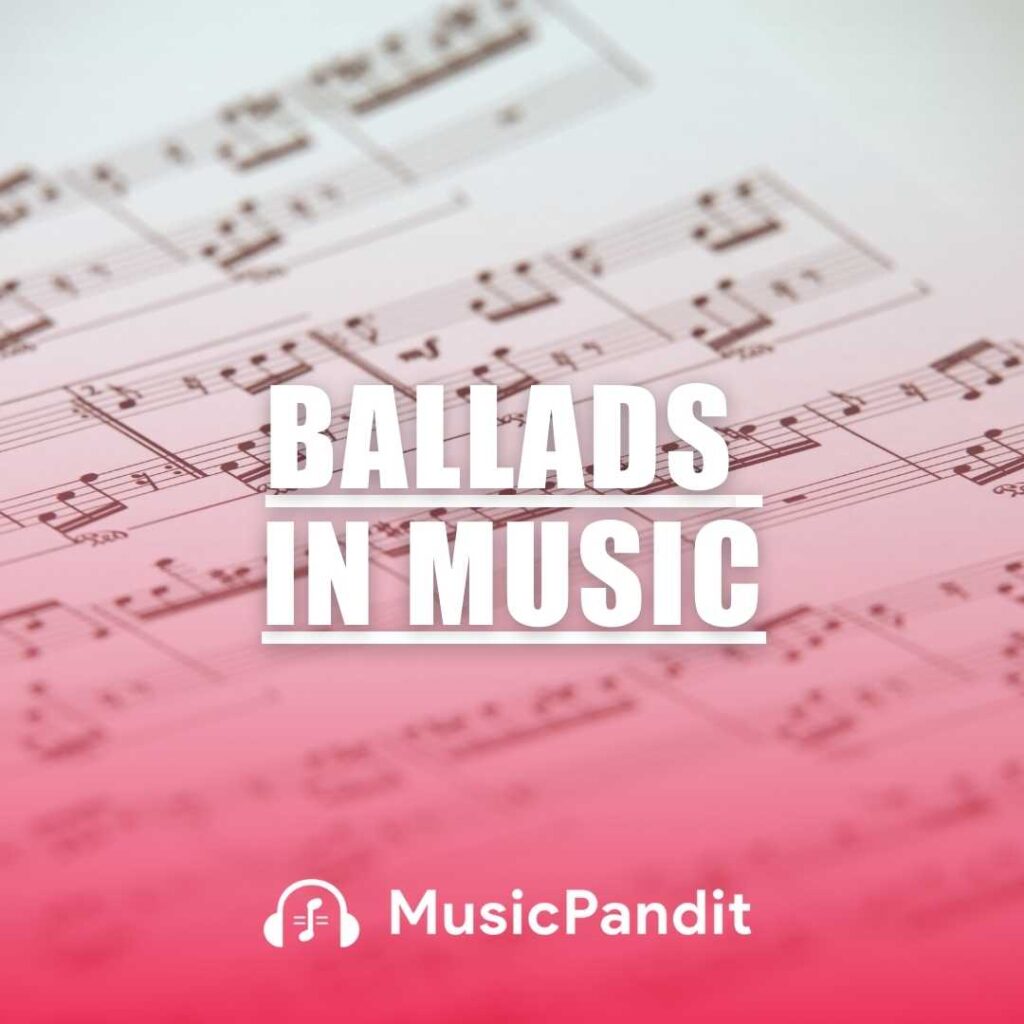Ballads have been a significant part of music and poetry for centuries, telling stories that captivate audiences with their emotional depth and melodic beauty. This guide will explore the world of ballads, providing young music students with a thorough understanding of their definition, history, structure, examples, importance, and practical aspects related to performance and composition.
Also Read: Music and Emotions
What is a Ballad?
A ballad is a type of narrative poem or song that tells a story. Traditionally, ballads were passed down orally and often set to music, making them a staple in folk traditions. They typically consist of short stanzas and have a repetitive structure, which makes them easy to remember and perform.
Historical Background
Ballads originated in the medieval period and were prevalent in Europe, especially in Great Britain and Ireland. They served as a means to share stories, news, and events among communities. Over time, ballads evolved from simple folk songs to more complex compositions, influencing various music genres, including pop, rock, and country.
Also Read: Explore Different Music Genres in Online Lessons For Your Child
Structure and Form
Traditional ballads often follow a specific structure:
- Stanzas: Typically composed of four-line stanzas, known as quatrains.
- Rhyme Scheme: Commonly use an ABCB or ABAB rhyme scheme, where the second and fourth lines rhyme.
- Meter: Often written in a meter called common meter, which consists of alternating lines of iambic tetrameter (eight syllables) and iambic trimeter (six syllables).
This structure contributes to the musical rhythm of ballads, making them engaging and memorable.
Examples of Ballads
Ballads span various genres and periods. Here are a few notable examples:
- Traditional Folk Ballad: “Barbara Allen” – A classic folk ballad telling a tale of love and loss.
- Literary Ballad: “The Rime of the Ancient Mariner” by Samuel Taylor Coleridge – A lengthy narrative poem that mimics the traditional ballad form.
- Modern Ballad: “Yesterday” by The Beatles – A contemporary song that embodies the ballad’s emotional storytelling.
Also Read: Online Piano Lessons VS Traditional In-Person Lessons
Importance and Uses of Ballads
Ballads play a crucial role in both music and literature:
- Storytelling: They convey stories, emotions, and events, preserving cultural narratives.
- Emotional Expression: Ballads often explore themes of love, tragedy, and adventure, allowing artists to express deep emotions.
- Cultural Preservation: They serve as historical records, capturing the values and experiences of the time.
Benefits of Studying Ballads
For music students, studying ballads offers several benefits:
- Enhanced Musicality: Understanding the structure and rhythm of ballads can improve musical composition and performance skills.
- Improved Storytelling: Learning how to convey a narrative through music enhances expressive abilities.
- Cultural Awareness: Exploring ballads from different periods and regions broadens cultural understanding.
How to Write a Ballad
Writing a ballad involves combining storytelling with musical elements. Here’s a step-by-step guide:
- Choose a Theme: Select a story or emotion you want to convey, such as love, adventure, or tragedy.
- Create a Structure: Plan your ballad in quatrains with a consistent rhyme scheme (ABCB or ABAB).
- Develop a Narrative: Write a clear beginning, middle, and end to your story.
- Incorporate Repetition: Use refrains or repeated lines to create rhythm and emphasis.
- Add Musical Elements: Consider the melody and how the lyrics will fit with the music.
Instrumental and Vocal Techniques for Ballads
Performing ballads requires specific techniques to convey their emotional depth:
Vocal Techniques
- Warm-Up: Always warm up your voice before singing to prevent strain. Simple exercises like humming can be effective.
- Breath Control: Practice deep breathing to support sustained notes and phrases.
- Emotional Expression: Focus on conveying the story’s emotions through your tone and dynamics.
For a practical demonstration of singing techniques for ballads, you might find this video helpful:
Also Read: Essential Tips for Improving Your Child’s Hindustani Vocal Technique
Instrumental Techniques
- Accompaniment: Use instruments like the guitar or piano to provide a harmonious background that complements the vocal melody.
- Dynamics: Vary the volume and intensity to match the narrative’s emotional highs and lows.
- Tempo: Maintain a steady tempo that reflects the ballad’s mood, typically slow to moderate.
Also Read: What are the Fundamentals of Learning to Play an Instrument?
Related Topics
Exploring ballads can lead to a deeper understanding of related musical and literary concepts:
- Folk Music: Traditional music that shares similarities with ballads in storytelling and structure.
- Narrative Poetry: Poems that tell a story, often using the ballad form.
- Lyric Ballads: A combination of lyrical poetry and ballad storytelling, as seen in works by poets like William Wordsworth.
Conclusion
Ballads are a timeless form of musical and poetic expression, blending narrative storytelling with melodic elements. By studying and performing ballads, young musicians can enhance their musical skills, deepen their emotional expression, and connect with rich cultural traditions. Whether you’re composing your own ballad or interpreting an existing one, remember to focus on the story you want to tell and the emotions you wish to convey.
For further exploration, consider listening to various ballads across different genres and periods to understand their diversity and impact. Happy singing and storytelling!
Explore Latest Music Articles
Source:https://www.musicpandit.com/resources/articles/ballads/

